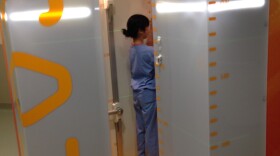3-D printing technology lets diagnostic radiologists easily create models of body parts to aid doctors in planning complex medical procedures. Dr. Mark Michalski, a resident in diagnostic radiology at Yale University, is developing innovative medical uses of 3-D printing and recently wrote an article for JAMA on the potential applications of the technology.
“We start with medical imaging,” says Michalski, “We convert that into a 3-D model that can be made out of lots of different materials, everything from plastic, to metal, and even a material similar to drywall.”
He spoke with Sound Medicine about the technology. Read on for highlights of his interview.
How 3-D modeling helps doctors with complex bone fractures:
We can first give these models to trainees, so that they can understand that the stereotypical pattern for these fractures really is. And second, when surgeons need to figure out what kind of hardware they're going to use for, say, a hip replacement, then we can use these models to test out the hardware, as opposed to actually having to go into the OR and have the patient under general anesthesia for a longer time testing out the hardware. This way, the surgeon knows exactly what the fracture looks like, what he or she will need to do to repair that fracture.
How 3-D printing a stint helped save the life of an infant with breathing troubles:
It was made out of a polymer material that resorbs -- which means the body can actually take that and absorb it over time. The nice thing about this 3-D printed stint was that it was just big enough to keep the airway open for the infant. Over time the material goes away.
The researchers on that study were able to take CT images and get that stint exactly the size and length they needed to keep that airway open. So instead of using a device that isn't personalized, they were able to create something that would fit better and keep the airway open more effectively.
3-D printing for organs may not be far away:
People are exploring 3-D printing for actually making organs. Now this work is very early on, and it's fair to say there's a bit of research that needs to take place. But the promise is that you could potentially print a brand new organ that is personalized for you, and be able to transplant those organs.
As you may know that the transplant backlog for many critical organs, the waiting list is quite long, and there's a huge need for those sorts of organs, so that would be a transformative innovation.
See a video of Michalski explaining the process of 3-D printing here.
Photo Credit: Army Medicine/Flickr





